India is a land where people of different religious beliefs live in coordination and brotherhood. India being part of the world’s oldest civilizations is a land of rich history, countless beliefs, traditions and legends surrounding the religions. Every temple has a unique history and legend attached to it. There are thousands of temples in India that are a must-visit owing to their place in history and mythology and also because these are architectural marvels, that are symbols of India’s rich cultural past. Here are 10 most famous temples in India.
Tirupati Balaji Temple:
The Temple is dedicated to Lord Vishnu, also known by other names like Tirumala Temple, Tirupati Temple, Tirupati Balaji Temple. This temple also as Kaliyuga Vaikuntha and the Lord here is referred to as Kaliyuga Prathyaksha Daivam. People believed to have lord Vishnu appeared here to save mankind from the trials and troubles of Kali Yuga. Temple situated on the hill Tirumala at Tirupati in Chittoor district of Andhra Pradesh, India. It is located on seven hills, is also referred to as Sapthagirisha or Lord of Seven hills. It is the richest temple in the world in terms of donations received and wealth. The temple is visited by around 50,000 to 100,000 pilgrims daily, while on special occasions and festivals, like the annual Brahmotsavam, the number of pilgrims shoots up to 500,000. It is the most-visited holy place in the world. In the temple idol of the lord is 8-feet tall, area of the temple is spread 26 kilometers.

Fascinating facts:
- Idol appears centrally aligned, but the fact of the matter is that the deity is located in the right-hand corner of the sanctum. Idol does not have a central orientation.
- Lamps in front of the deity have been burning seemingly since eternity.
- According to local myth, the source of the flowers, milk, and other items that are directly used for the ritualistic worship of the deity, all these come from a village which is about 20 kilometers away. The name and location of the village remain a mystery known only by those who inhabit it.
- If you keep your ear close to the idol’s back, you will hear the sound of enormous seas waves.
- The idol has real hair and they never get tangled.
- After the morning Abhishekam, the idol sweats, and the sweat is wiped with a silk cloth.
Kashi Viswanathan temple
Kashi Vishwanath Temple is a famous Hindu temple dedicated to Lord Shiva, amongst the most salient temples in the holy Varanasi which attracts a lot of pious devotees yearly, from all around India. It is in Varanasi, Uttar Pradesh, India. The temple stands on the holy river Ganga, one of the 12 Jyotirlingas also known as Vishwanatha or Vishweshwarar meaning ‘the ruler of the universe. The temple has 800 kg of gold plating on its tower. The temple is composed of three parts. The first is a spire on the temple of Lord Vishwanath, the second a gold dome and the third is the gold spire atop the Vishwanath carrying a flag and a trident. It had been destroyed by many Muslim rulers many times, most recently by Aurangzeb, the sixth Mughal emperor who constructed the Gyanvapi Mosque on its site. The current structure was built on a nearby site by the Maratha ruler, Ahilya Bai Holkar of Indore in the year 1780. Since 1983, the temple has been handled by the government of Uttar Pradesh. On December 13, 2021, Prime Minister Narendra Modi fervent the newly built Kashi Vishwanath Corridor to the nation. It was spread across only 3,000 square feet before the project started and now spreads over a 5,00,000 square feet area.
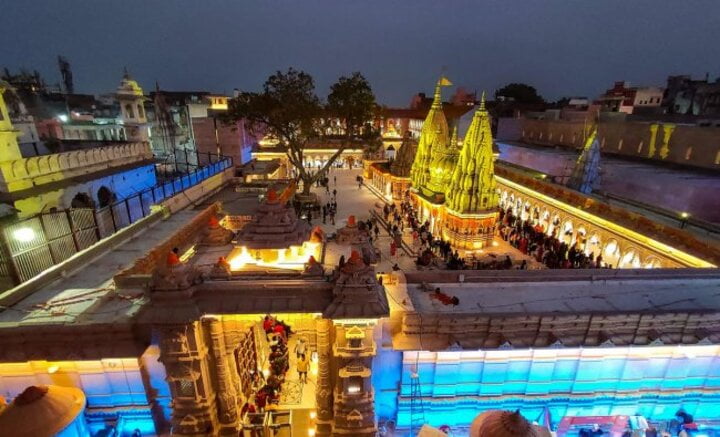
Fascinating facts:
- According to records, the Kashi Vishwanath temple was founded in 1490. The temples were plundered time and again by the Mughals. The original temples were re-built, then destroyed and re-built.
- FYI, Mughal Emperor Akbar permitted to build the original temple, which was later destroyed by Aurangzeb – the sixth Mughal emperor, who ruled over almost the entire Indian subcontinent for 49 years.
- The Kashi Vishwanath temple was last rebuilt and restored to its glory by the Queen of Indore, Rani Ahilya Bai Holkar. She took the initiative to restore the temple and also provided the funds for it. However, later Akbar’s great-grandson Aurangzeb had destroyed the temple and built a mosque in its place.
- It is said that when news reached Aurangzeb’s plans to destroy the temple, the idol of Shiva was hidden in a well to protect it from destruction. The well, called the “well of wisdom”, still stands there between the mosque and the temple.
- Kashi was originally derived from the Sanskrit word ‘Kas’ which means ‘to sparkle’. With numerous attacks and plunders over the centuries, the city’s resilience is much appreciable!
- The Kashi Vishwanath Temple has three domes covered of gold! The golden chatra on top is believed to fulfill any wish that is made after seeing it.
Mata Vaishno Devi Temple
The second-most visited Hindu pilgrimage destination in India, Mata Vaishno Devi Cave Temple is situated in the Trikuta Hills in Katra, Jammu & Kashmir. This place is the most important Shaktipeeth as it is believed, here the skull of the Goddess Sati fell. The temple, at a height of 1,584.96 m (5,200 ft), is 12 km from Katra on Trikuta hill. It is about 61 km from Jammu city. The Divine Mother rests at this place in the glorious form of Vaishno Mata who is believed to be a symbol of Goddess Mahakali, Mahalakshmi, and Mahasaraswati. The idol of the main deity is found in the form of natural Pindies (stone structure). These three structures symbolize the creative, preservative, and destructive characters of the mother. While one takes a journey up the hill to the temple, one can enjoy natural beauty at its best. An estimated number of eight million pilgrims visit the holy site every year, making it the second most visited pilgrimage site after Thirumala Tirupati.
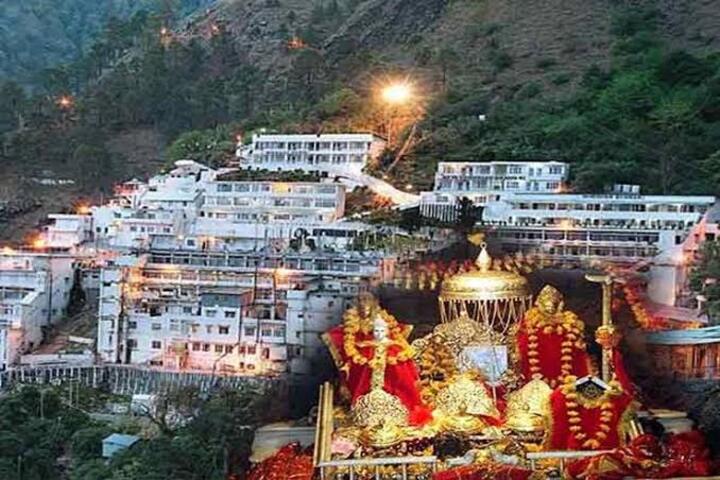
Fascinating facts:
- The Vaishno Mata Temple was built with five rock structures that resembles Pandavas.
- Researches did much research on these caves but they could not find the exact origin of the temple.
- Devi killed Bhairavnath with Trident that is Trishula where his head fell into the valley and body in the cave.
- Devi in the form of rock.
- To escape from Bhairav Nath, Mata hide herself in a cave near Ardhkuwari for nine months, cave is named as Garbhjun.
Bhramha temple
Pushkar Brahma temple at Pushkar may well be the most famous one in the world dedicated to Brahma but it certainly isn’t the only one. Brahma Mandir is a Hindu temple also known as Jagatpita Brahma Mandir situated at Pushkar in the Indian state of Rajasthan, close to the sacred Pushkar Lake. Temple structure dates from the 14th century. The temple is described to have been built by sage Vishwamitra after Brahma’s yagna. It is also believed that Brahma himself chose the location for his temple. The 8th century Hindu philosopher Adi Shankara renovated this temple, while the current medieval structure dates to Maharaja Jawat Raj of Ratlam, who made additions and repairs. the temple is constructed with stone slabs and blocks that are fixed together with molten lead. The walls and the marble floor (in black and white checks) have been studded with hundreds of silver coins by worshippers with their names etched on them. These coins are a mark of offerings by devotees to their worshipper, Brahma and a hamsa bird (goose or swan) motif, and topped by a distinctive red spire.
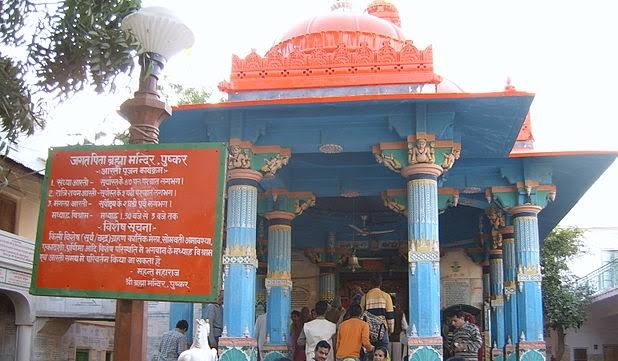
Fascinating facts:
- Pushkar is often described in the ancient scriptures as the only Brahma temple in the world and as the “King of the sacred places of the Hindus”
- The legend has it that Brahma once lied about an accomplishment. It happened when Brahma Ji and Vishnu Ji were finding the head and foot of a pillar light respectively. During this task, they both got tired and quit. While Vishnu Ji accepted that he was unsuccessful, Brahma Ji lied. Using his powers, he presented a flower as evidence of reaching the top of the pillar light. The moment Shiva learned about the lie, he cursed Brahma Ji that there would be no temple dedicated to worshipping as he was unworthy.
- In another story, Brahma created a beautiful female deity, known as Shatapura, and immediately became infatuated with her. However, Shiva decided this was wrong and punished Brahma by directing that no one on Earth should worship him.
- In Pushkar popular stories, they say that it was Savitri, Brahma Ji’s wife, who cursed him. Brahma married a beautiful local girl, Gayatri for the purpose. When Savitri learned about this, she rushed to the place and cursed Brahma Ji that he would not be worshipped anywhere. After her anger subsided, she added to the curse that Pushkar would be the only place where there will be a temple dedicated to his worship.
- Among the ancient Hindu temples in Pushkar, only a few have survived the wrath of time. The Mughal emperor Aurangazeb had destroyed most of the Hindu temples in Pushkar and it’s an irony that the old temple of Lord Brahma is still perching on the sacred shores of Pushkar.
- It is believed that the Pushkar lake was formed out of a petal that fell from Lord Brahma’s lotus!
- The ancient Hindu scriptures describes the lake of Pushkar as “Tirtha-Raj” – the king of sacred water-bodies. Surrounded by 52 bathing ghats, pilgrims throng in to the Brahma temple in large numbers, after bathing in this sacred lake.
Dwarkadhish Temple
Dwarkadhish Temple also known as the Jagat Mandir or Trilok Sundar, dedicated to Lord Krishna. The temple is located at Dwarka city of Gujarat, India, which is one of the destinations of Char Dham, a Hindu pilgrimage circuit. The temple was developed in the 15th- 16th century around 2,000 – 2,200 years old. According to tradition, the original temple was believed to have been built by Krishna’s grandson, Vajranabha, over the Krishna’s residential place. The original structure was destroyed by Mahmud Begada in 1472. The ancient temple has been renovated several times, especially leaving imprints of 16th and 19th centuries. The temple stands on a small hill accessed by 50 plus steps, with heavily sculptured walls that cocoon the sanctum with the main Krishna idol. Around the complex lie other smaller shrines. The walls have intricately carved mythical characters and legends. The impressive 43 m high spire is topped with a flag made from 52 yards of cloth that flutters in the soft breeze from the Arabian Sea behind the temple. The temple is built of soft limestone and consists of a sanctum, vestibule and a rectangular hall with porches on three sides. The temple has two gates – Swarg Dwar in the south and Moksha Dwar in the north.
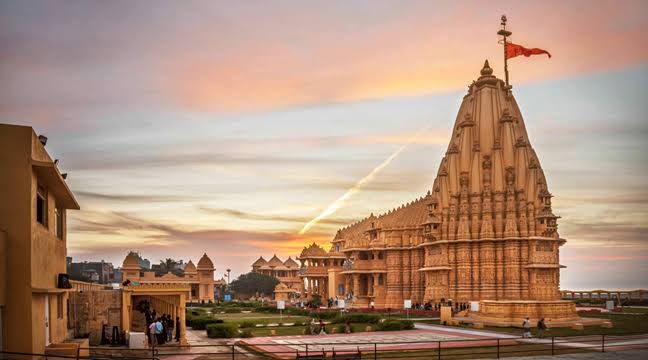
Fascinating facts:
- According to legends, the Dwaraka kingdom was founded by Lord Krishna 5000 years ago. The kingdowm with 9 lakh extravagant structures were constructed in silver and gold. A underwater part of Dwarka is a major attraction here.
- Constructed around the 15th century, this temple is black marbled Lord Krishna’s Idol. It is designed as per Chaulkya style using high-quality limestone.
- Dwarka means ‘gates of heaven’ and this becomes almost true when you see the entrance of Dwarkadhish temple. It has two entrances, the northern one is called Moksha Dwara, and southern entrance is called Swarga Dwara.
- This temple is dedicated to the Wife of Lord Krishna. It situated at the distance of just 2 km from Dwarkadheesh Temple. There is one mythological story attached to this temple according to which Rishi Durvasha cursed Devi Rukmani that she will get separated from Lord Krishna.
- The most amazing thing is that famous Dwarkashesh temple is situated just 56 steps from the Gomti river. This is the reason, in Dwarka number 56 is considered as very auspicious.
- As per the Hindu Epic, Mahabharata, due to flood, once Dwarka land got flooded into the sea and then to help residents of Dwarka, Lord Krishna get back the land from the sea and convert it into Dwarka City.
Badrinath temple
The Badrinath Temple also known as the Badrinarayan Temple, located in Chamoli district Uttarakhand , India. Badrinarayana Temple is a Hindu temple dedicated to Vishnu . It is open for six months every year between the end of April and the beginning of November, because of extreme weather conditions in the Himalayan region. The temple is placed in Garhwal hill tracks in Chamoli district along the banks of Alaknanda River. It is one of the most visited pilgrimage regions of India. Established as a major pilgrimage site by Adi Shankara in the ninth century. Adi Shankara established Badrinath as a pilgrimage site in the ninth century. Shankara discovered the image of Badrinarayan in the Alaknanda River and enshrined it in a cave near the Tapt Kund hot springs. In the sixteenth century, the king of Garhwal moved the murti to the present temple. The temple has undergone several major renovations, due to age and damage by avalanche. In the seventeenth century, the kings of Garhwal expanded the temple. After significant damage in the great 1803 Himalayan earthquake, the King of Jaipur rebuilt it. Some accounts claim that the temple had been built on a former Buddhist temple site. The temple has three structures: the Garbhagriha (sanctum), the Darshan Mandap (worship hall), and Sabha Mandap (convention hall). The conical-shaped roof of the sanctum, the garbhagriha, is approximately 15 m (49 ft) tall with a small cupola on top, covered with a gold gilt roof. The facade is built of stone and has arched windows. A broad stairway leads up to the main entrance, a tall, arched gateway. Just inside is a mandap, a large, pillared hall that leads to the sanctum, or main shrine area. The walls and pillars of the hall are covered with intricate carvings. The main shrine houses the 1 ft (0.30 m) Shaligram (black stone) deity of Lord Badrinarayana, which is housed in a gold canopy under a Badri Tree. The deity of Lord Badrinarayana shows him holding a Shankha (conch) and a Chakra (wheel) in two of His arms in a lifted posture and the other two arms resting on His lap in a Yogamudra (Padmasana) posture.
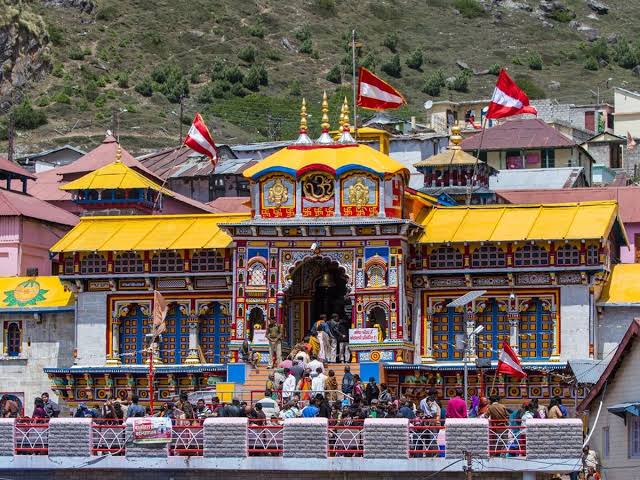
Fascinating facts:
- The name of the Badrinath Temple originates from a known word badri which is said a type of wild berry. A mythological story increases the faith of devotees. The story is when Lord Vishnu sat in penance in the mountains of Badrinath, Goddess Laxmi changed herself in berry tree to shade her husband from the harsh sun. That is why sages and pilgrims’ belief in meditating here for mental peace and enlightenment.
- The Concept of re-birth ends if a person visits Badrinath Temple. That gives end of release from the cycle of Life and Death, and that is the main reason everyone wants to visit at least once in a lifetime to the pilgrimage.
- There is a lamp which continuously glows from the last six months when the door opens. The faith unfolds a story that Gods lights that lamp when no one stays at this place due to extreme cold.
- The Badrinath Temple was worshipped as Buddhist Temple too, during the reign of Asoka.
- Badrinath is also known as “Badri-Vishal”. There is a peak near Badri-Vishal which is known As Swargarohini or the Path of Heaven.
Kedarnath Temple
Kedarnath, a popular Hindu temple, situated Garhwal Himalayas near the Mandakini river, some 221 km from Rishikesh in Uttarakhand. Temple is one of the twelve Jyotirlinga of Lord Shiva. The temple is open to the public only between the months of April and November. T The name “Kedarnath” means “the lord of the field” it derives from the Sanskrit words kedara and natha. The text Kashi Kedara Mahatmya states that it is so called because “the crop of liberation” grows here. Kedarnath. Mandir is said to have been constructed by Adi Shankaracharya in the 8th century A.D. Kedarnath in the form of lingam is of irregular shape with a pedestal 3.6 m (12 ft) in circumference and 3.6 m (12 ft) in height. There is a small pillared hall in front of the temple, that has images of Parvati and of the five Pandava princes. Outside the temple door, a large statue of Nandi stands as guard. The temple has been continually renovated over the centuries. The Shiva Lingam of the Kedarnath temple is a triangle shape and hence is unique among Shiva temples. which is placed in the sanctum sanctorum (Garbha Griha) of the temple. The Kedarnath temple houses idols of Parvati, Lord Krishna, five Pandavas and their wife Draupadi, Nandi, Veerabhadra and other gods and goddesses along with the vehicle Nandi of Lord Shiva. The Kedarnath temple’s height is 85 feet, 187 feet length and the width is 80 feet. The walls of the Kedarnath temple are 12 feet in thickness and are made of incredibly strong stones.
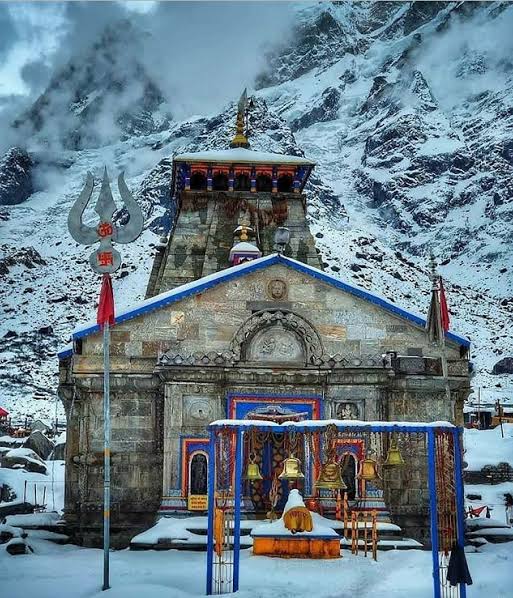
Fascinating facts:
- The Kedarnath temple is protected by Lord Shiva. In 2013 intense rains of monsoon caused floods and landslides, resulting in the destruction of the entire surroundings of Kedarnath. Many locals and devotees died that year due to the devastation of nature but the temple of Kedarnath remained intact as if some divine power was protecting it from destruction.
- Ghee holds a very important place in the temple of Kedarnath. Devotees rub the lingam with ghee which is considered auspicious. Pouring ghee into the lingam is a sacred ritual.
- The linga is also considered a form of Himalaya Mountain. People of Garhwal also consider the lingam a mountain in which they live as Lord Shiva lived in the mountain and formed from a mountain emerging from the ground in a triangular shape.
- It is said the temple of Kedarnath is protected by Bhairavnath Ji Temple as he is the temple guardian.
- The Mantras are chanted in the Kannada language in Kedarnath temple
- The temple walls are covered with thick rock and its roof is made of a single stone.
- Kedarnath temple was completely under snow for 400 years, after which this temple came to light.
Jagannath Dham
The Jagannath Temple is an important Hindu temple dedicated to Krishna, Devi Subhadra and elder brother Balabhadra are being worshipped in Puri, one of the Char Dham pilgrimage sites. This temple is situated of puri state of Odisha, India. Temple constructed by a famous king of Ganga Dynasty Ananta Varman Chodaganga Deva dating back to 12th century at the seashore Puri. The main temple of Jagannath is an impressing and amazing structure constructed in Kalinga architecture, with a height of 65 meters placed on an elevated platform. The huge temple complex covers an area of over 400,000 square feet, and is surrounded by a high fortified wall. This 20 feet high wall is known as Meghanada Pacheri. Another wall known as kurma bedha surrounds the main temple. It contains at least 120 temples and shrines. With its sculptural richness and fluidity of the Oriya style of temple architecture, it is one of the most magnificent monuments of India. The main temple is a curvilinear temple and crowning the top is the ‘Neelachakra’ (an eight spoked wheel) of Lord Vishnu. It is made out of Ashtadhatu and is considered sacrosanct. Among the existing temples in Orissa, the temple of Shri Jagannath is the highest. The temple tower was built on a raised platform of stone and, rising to 214 feet above the inner sanctum where the deities reside, dominates the surrounding landscape. The pyramidal roofs of the surrounding temples and adjoining halls, or mandapas, rise in steps toward the tower like a ridge of mountain peaks. The temple has one of the largest kitchens of India, the lip-smacking food is cooked in earthen pots for thousands every day and offered to devotees. The vibrant religious festivals of the town allures tourists in large numbers. The most awaited of them is the Rath Yatra celebrated with immense gusto.

Fascinating facts:
- Jagannath Temple flag flows in the opposite direction to the wind.
- Every day a priest scrambles the walls of the temple with a height equivalent to that of a 45 storey building, to change the flag atop the temple dome.
- The chakra is actually 20 ft high and weighs a ton. It is fitted on top of the temple. But what is interesting about this chakra is that, you can see this chakra from any corner of the Puri city.
- No birds or planes fly above the temple.
- The structure of the temple is such that it does not cast any shadow at any given time of the day.
- When you enter the temple from the Singha Dwara, the noise of the ocean waves is lost. It is when you step out of the temple that you are able to hear it again. This is another phenomenon and there is no scientific explanation for this.
- The prasadam prepared in the temple is never wasted.
- In the kitchen of the Jagannath Puri temple, the Mahaprasadam is cooked in 7 sacred pots placed atop of each other. Surprisingly, the food in the top most pot cooks first and then in the 6 pot and so on. This denies the natural science of cooking.
Sirdi Sai Baba Temple
Shirdi Sai Baba temple is located in Shirdi, a small city in Ahmednagar District in Maharashtra, India. The city is known as the home of the 19th-century saint Shri Sai Baba. Sai Baba of Shirdi also known as Shirdi Sai Baba, was an Indian spiritual master identified as a saint and a fakir. The word Sai means Sakshaat Ishwar, God. And Baba is an honorific signifying grandfather, father, old man or sir. Thus Sai Baba denotes “holy father”, “saintly father”. He was likely born around 1838 and died 15 October 1918. He was revered by both his Hindu and Muslim devotees during, as well as after, his lifetime. Sai Baba is popularly known as the ‘child of God’, as he always spread the message of universal brotherhood. He wanted his followers to develop two important characteristics- faith (Shraddha) and patience (Saburi), lead a moral life, help others and love every living being without any discrimination. He encouraged sharing, performing one’s duties without any earthly attachments and being content always. The temple is spread in an area of about 200 sqm in the heart of Shirdi village. On average, 25,000 devotees visit Shirdi village for Darshan daily. During the festival season, this number swells to over 100,000 devotees per day. The temple has been built by a millionaire from Nagpur, Gopal Rao Booty, who was a great follower of Sai Baba. The statue of Sai Baba was installed on the day of Dussehra (7 October 1954), which was 36 years after Sai Baba took Maha-samadhi.

Fascinating facts:
- When Sai Baba came to Shirdi, he used to spend most of his time under a neem tree which is now known as Gurusthan, the neem leaves here don’t taste bitter but sweet. It is believed that those who get a chance to have a neem leaf from the tree have a healthy life and suffer from no diseases.
- Drinking laws are different in Shirdi. Alcohol is neither sold nor served in the city.
- Years after people worshipping him, no one knows what is the real name of Sai Baba. He was called Fakir due to the way he dressed.
- In 2012, K.V Ramani donated Rs.110 crores for an Ashram, which accommodates 14,000 devotees.
- According to the 2011 census, Shirdi’s average literacy rate is 70 per cent with male literacy at 76 per cent and female literacy at 62 per cent. The national average literacy rate is 59.5 per cent.
- All through the world, there are around 2000 temples for Sai Baba. In India, Shirdi Sai Sansthan is the richest temple following Tirupathi, located in Andra Pradesh.
- Sai Baba’s disciples and devotees have claimed that he has done many miracles likemind reading, levitating, entering a state of samadhi at will, lightning of lamps with the help of water, curing the unknown and incurables, and it is told that he saved people life from a major disaster, a falling mosque that could have killed many people.
Ramnathaswamy temple
Rameshwaram Temple, also known as Ramanathaswamy Temple of Tamil Nadu is dedicated to Lord Shiva. At the beginning, the Rameshwaram Temple was just a shed. In the seventeenth century, Dalavai Setupati built a portion of the eastern Gopuram. In late eighteenth century, the world-famous third corridor called as Chokkatan Mandapam was constructed by Muthuramalinga. The contribution of the Jaffna kings of the Sethupathy dynasty to the Ramanathaswamy Temple was also commendable. King Jeyaveera Cinkaiariyan helped in shipping stone blocks from Koneswaram temple to renovate the temple. His successor Gunaveera Cinkaiariyan looked after the structural development of this temple. The wall measures about 865 feet from east to west and 675 feet from north to south. The long corridors running between huge colonnades on five feet high platforms forms part of the temple’s interior. The second corridor is built with sandstone pillars, beams and ceiling. On the west lies the third corridor which paves the way to Setumadhava shrine. The total length of these corridors is around 3850 feet and are reputed to be the longest in the world. There are 1212 outstanding pillars in the outer corridor of the Rameshwaram Temple and rajagopuram is the 53 metres tall prominent tower amongst all. The main halls of the temple are- Anuppu Mandapam, Sukravara Mandapam, Setupati Mandapam, Kalyana Mandapam and Nandi Mandapam. There are two lingams inside the temple. The first one is the main deity, Ramalingam and was built by Sita. The second one, Vishwalingam, was brought by Hanuman from Kailash. Apart from this, there are twenty-two tirthas or holy water bodies located inside the temple premises. The devotees take baths in tirthas to get rid of their sins. The major one is Agni Theertham.
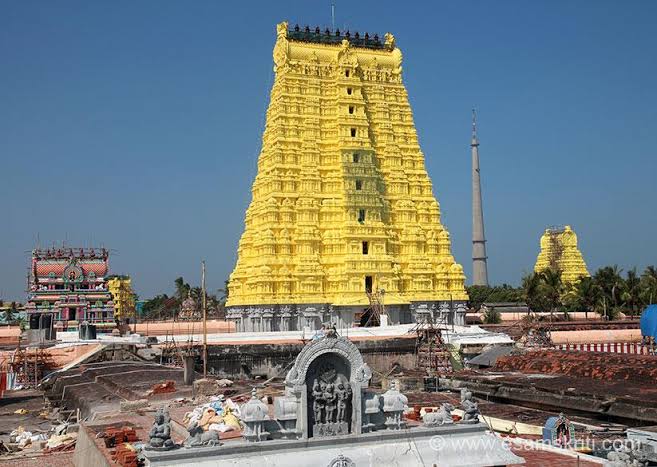
Fascinating facts:
- The temple was built with unusual structure that you would think that it is a huge concrete chess board the moment you see it for the first time. Granite stones were the main materials used in its reconstructions.
- It’s said the main deity Ramalingam who was formed by Goddess Sita from sand materials. The Vishwalingam was brought from Kailash by Lord Hanuman.
- According to Ramayana, Rama is prayed to Shiva here to absolve sin of killing a brahmana during his war against the demon king Ravana. Rama wanted to worship Shiva. Rama ordered Hanuman to bring the lingam from Himalayas. Since it took longer to bring the lingam, Sita built a small lingam out of the sand available in the sea shore, which is believed to be the lingam in the sanctum.
- Unknown fact is that the Third corridor in the Rameswaram Temple is considered as the world’s largest temple corridor. Truely Impressive !!.
- These pillars are extremely helping for the stronger foundation of the Rameshwaram Temple, causing it not to fall down or collapse very easily. Each of these pillars is carved with magnificent and artistic Hindu carvings. Furthermore, the exact height of every pillar this temple has is 30 feet.
- The Char Dham (4 abodes) are defined by the Pandavas in the Mahabharata as “Badrinath“, “Kedarnath“, “Gangotri” and “Yamunotri”. They were four places that the Pandavas believed could cleanse people of their sins.
- According to Hindu scripts, there is only 12 Jyotirlingain the continent, which appeared by themselves. The temple houses one of the 12 Jyotirlingas. It is usually believed that those who visit all these 12 Jyotirlingas would attain moksha and would be free from the cycle of birth and death. Along with this, they get the blessing of Lord Shiva.

